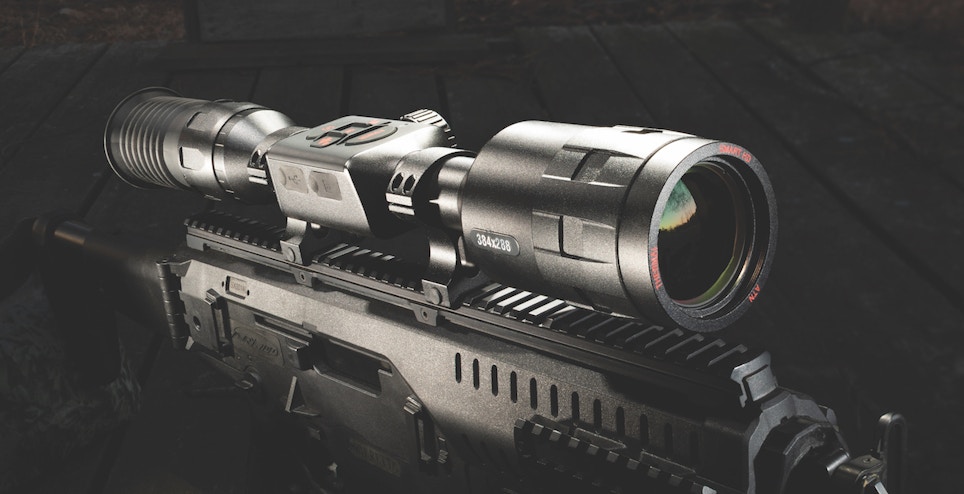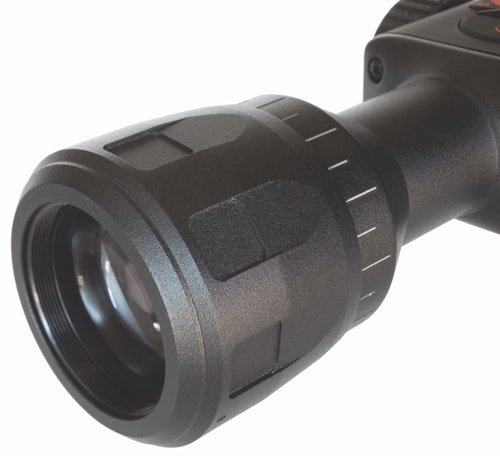Technology has transformed many time-consuming and painful chores into tasks completed in mere seconds. Its integration to the outdoor sports, however, has been somewhat lethargic, partly because of the conditions encountered there, but also because there’s no shortage of enthusiasts who prefer a traditional flavor in their pursuits. The features packed into ATN’s ThOR 4.5x50mm Thermal Smart HD scope might force those in the latter group to reconsider.
Let’s face facts. The amount of time we get to spend hunting each year is finite, defined by seasons, work schedules, family obligations and the number of daylight hours. Quality night vision doesn’t reduce the scheduling conflicts, but it elegantly addresses the other restriction.
You might be surprised how long the basic technology has been around. The first night vision came out of Germany in the 1930s and saw limited use by Axis powers during World War II. The United States had its own version, although both systems relied on a transmitter to flood areas downrange with infrared light. That transmission — at a frequency just below red in the visible spectrum — is undetectable to the naked eye, until it’s viewed through a properly equipped optic.
Those units were bulky and heavy compared to the generations that followed. Vietnam-era starlight systems were next to capture the public’s imagination, but the first generations were rudimentary compared to what’s available today.
Unfailing performance and the ability to thrive through abuse are mandatory in modern military versions. The average model designed for hunting can’t claim the same characteristics, although ATN is ushering in a long overdue change, without abandoning any of the advantages made available by modern technology. In fact, the company has added a few, but it’s all for naught unless that body is built to withstand the rigors of the outdoors.
Built to Last
Aluminum-alloy construction on the ThOR 4.5-18x50mm Thermal Smart HD scope ensures it can take punishment. Even the keys with rubberized coating on the control panel have a solid and stout structure underneath. The optic does not have a waterproof rating, although it is weatherproof. It’s going to take some negligence to break this scope, however, thanks to its clever design. The weakest link is likely the pair of rubberized caps on the right side of the optic that cover a USB-type C connection and microSD card slot. Despite the fact they fit snug and didn’t work loose during testing, the openings could leak if submersed for any period. Their strategic location, however, on a vertical surface, minimizes risk of precipitation sneaking in.
Shooters can adjust the diopter to their eyesight by simply rotating the eyepiece. The fact that it’s somewhat stiff is a testament to internal sealing, as well as the company’s understanding that things get knocked around inadvertently when afield — particularly at night. Knurling on the surface provides a solid grip, even when wearing gloves. The scope is focused manually. That’s accomplished by rotating a ring up front on the circumference of the scope’s bell. It remains in position with authority and beveling also ensures easy manipulation in poor weather.
Zooming to a higher magnification is different from traditional hunting optics. The dial is on the left side of the scope, where most long-distance shooters are accustomed to finding a parallax adjustment turret. It works smoothly throughout its range, has palpable (but not audible) clicks when rotating to the next position and, like the other adjustments, the tautness makes internal sealing obvious. The scope’s main tube is 30mm, but a control box occupies about 3.5 inches of real estate between the objective lens and eyepiece. While that could present a logistical problem for mounting, ATN wisely includes two bases and rings, along with an L-shaped base to ensure units mounted on rails with limited Picatinny space can still be configured for proper eye relief (which is 90mm or slightly more than 3.5 inches).
Behind the Trigger
Extended range sessions with a Beretta ARX-100 chambered in 5.56 NATO indicate all reticle options hold point of impact in enviable fashion. The scope exhibited the same virtue with a few dozen 6.5 Creedmoor rounds through a Bergara Ridge rifle, although the ammunition shortage limited that testing. The scope’s body and electronics are tailored to handle recoil and will undoubtedly survive the heavier loads.
It’s important to note that the view through the scope downrange, day or night, is black, white or shades between. The more thermal energy (heat/infrared) the object radiates or reflects, the lighter the tone. A coyote after a long run might appear almost completely white, although cooler hair tufts and bunches print gray pattens that make precise shot placement possible.
The reason for the monochromatic view is simple. Light gathered by the objective lens strikes a sensor tuned specifically to detect the infrared spectrum, not the wavelengths of visible light we see with the naked eye. The information it gathers includes intensity, which creates the gray contours and mid-tones. That data appears on an LCD display at the eyepiece after processing. Odds are good the mirror-like finish on the ThOR’s front glass does the heavy lifting when it comes to filtering most of the unwanted wavelengths.
The scope works extremely well, is extremely sensitive and does not require an external transmitter to present clear sight pictures. On a cloudy, dark night it peeked through a thickly forested trail at 400 yards without hesitation at 18X. Admittedly it’s not as intuitive as looking through a traditional daytime optic, but that’s not an option after the sun has set. The LCD display at the eyepiece is full color, but the rectangular downrange image it presents is always black and white (except the reticle in most cases). It’s far from a traditional view, but it was surprising how fast my comfort level grew with practice. Unfortunately, no animals appeared during testing.
All glass surfaces on the ThOR receive an anti-fog coating and because the image electronically transfers from the sensor up front to the LCD screen behind, there’s no benefit to gas purging the tube body. Sensor size on the tested optic was 384x288 17 micron, already dizzying in performance, but there’s also a 680x480 17 micron version of this scope.
Data Handling
Detecting infrared light downrange is one thing but building a mirror image on an LCD back at the eyepiece isn’t as simple as a direct wire connection. Add reticle placement, along with the ability to adjust contrast, brightness and more, and the view is only part of the voluminous number of calculations under way. The processes take place instantly and concurrently, precisely why ATN doesn’t hold back on ThOR’s brain, so to speak.
The scope uses the company’s Obsidian IV Dual Core T processor. To say “it works” is a gross understatement. There is no possible way to cover all its options and versatility in this short space. Get behind a ThOR if you can, or at least visit the company’s website and read the manual. Its agility is nothing short of amazing.
The dual-core processor makes a large part of the scope’s performance possible. Basically, instead of bogging down as the vast amount of information and ancillary requests flood in, some of the tasks are handed off to the other core. That speeds response and makes many other functions possible, all without sacrificing speed. The system’s dexterity is cutting edge.
Brightness and contrast are adjustable in the downrange view. If things seem too “noisy” in the image, there’s even the ability to add non-uniform conformity to the display. It’s visually like tuning an old-fashioned TV on UHF channels until on-screen interference is minimized. In testing it wasn’t necessary, but it’s a great asset in certain environmental conditions.
The scope’s functions and menu are operated by the push buttons atop the scope. The power switch is located toward the front of the five-button panel, and wisely requires depressing and holding it a few seconds to wake the processor. That minimizes inadvertent activation in the field and, when combined with the lithium-ion battery that provides more than 18 hours of continuous use, ensures the optic won’t go down unexpectedly. The USB is used for charging.
The scope has a one-shot zero function and a large list of reticles and colors from which to choose. Those are the basics we’ve all come to expect, but there’s a second core that refuses to remain idle.
The heads-up display — which is in color on the borders — provides detailed information, including e-compass reading, gun roll (cant), pitch (declination), whether a video is being recorded or photo and current zoom level (magnification). It also reports battery status, along with, Wi-Fi, Bluetooth, MicroSD card and whether the ballistic calculator is engaged and even values it’s using.
The scope can pair with the company’s ABL laser rangefinder, which in turn provides accurate and instant readings to the optic’s ballistic calculator, which automatically adjusts the crosshairs for a precise shot. The process is unnoticed when you’re behind the trigger. Operation of much of the menu on a smart device is made possible by enabling Wi-Fi and connecting to the ThOR.
By inserting the Micro SDXC card, you can also take photos, which displays briefly at the eyepiece screen. They save in jpg format and the clarity is good. They reflect the downrange view when you released the “shutter,” including the crosshairs. Unfortunately, it does not include any of the heads-up display information.
Video with audio is also possible at a resolution of 1280x960 at 60 frames per second. And if you’re interested in capturing crucial moments of your hunt without the requirement of pressing buttons when you need to be concentrating on the crosshairs, there’s also a recoil activated video (RAV) function. It runs continuously when on, but when it senses a shot it stores the moments just before your shot through a few seconds afterward. It’s a great way to share the experience. There’s also the ability to stream video, mil dot reticle options and even an ATN Radar function that can be used with a rangefinder to keep track of other members of your hunting party. Locations transmit to smartphones paired in the system.
Well Worth It
Undoubtedly, this scope performs its night vision duties with enviable dexterity. It comes with adjustments that rival many high-end cameras and does it all well at night. It’s not a flyweight, but that rugged construction reflects an ability to outlast the three-year warranty by years. Add the fact that it’s rated for operating anywhere from -20 to 120 Fahrenheit and it seems custom built for predator hunters eager to increase the time they can stay afield and pursue quarries that prefer prowling the dark.









